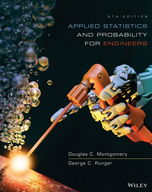Solution Found!
Solved: Consider the code in Example 2-12. Suppose that
Chapter 2, Problem 162E(choose chapter or problem)
Consider the code in Example 2-12. Suppose that all 40 codes are equally likely (none is held back as a delimiter).Let 𝐴 and 𝐵 denote the event that the first bar is wide and 𝐵 denote the event that the second bar is wide. Determine the following:
(a) \(P(A)\) (b) \(P(B)\) (c) \(P(A \cap B)\) (d) Are A and B independent events?
Equation transcription:
Text transcription:
P(A)
P(B)
P(A cap B)
Questions & Answers
QUESTION:
Consider the code in Example 2-12. Suppose that all 40 codes are equally likely (none is held back as a delimiter).Let 𝐴 and 𝐵 denote the event that the first bar is wide and 𝐵 denote the event that the second bar is wide. Determine the following:
(a) \(P(A)\) (b) \(P(B)\) (c) \(P(A \cap B)\) (d) Are A and B independent events?
Equation transcription:
Text transcription:
P(A)
P(B)
P(A cap B)
ANSWER:Solution
Step 1 of 4
Let A denote the event that the first bar is wide
Let B denote the event that the second bar is wide
a) We have to find P(A)
The no.of codes with 2 wide and 3 narrow bars ==10
The no.of codes begin with wide bar==4
Now
=4/10
=0.4
